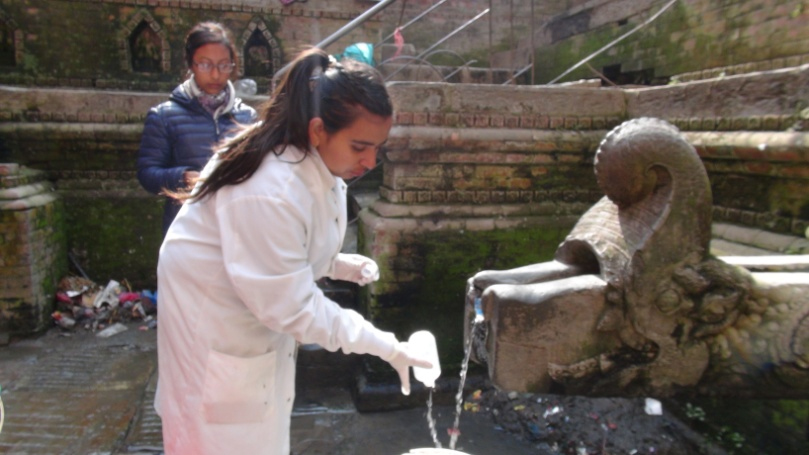About This Project
Water in the Kathmandu Valley often contains bacteria or unsafe levels of arsenic, manganese, or mercury. Previous research in Kathmandu (Warner et al., 2008) found that better-tasting water was more likely to contain bacteria. This project will examine how taste affects water choice and family health--does it help or hinder making the best choice of water sources? The project will also produce maps of groundwater contaminants for local water planning.
Ask the Scientists
Join The DiscussionWhat is the context of this research?
Finding safe drinking water is a problem in the Kathmandu Valley of Nepal. Previous researchers (Warner et al., 2008) found that local water often contains bacteria as well as toxic metals such as arsenic, manganese, and/or mercury. They noted that water that residents deem superior-tasting is more likely to cause disease than water from other sources that does not taste as good. This project will focus on taste and water source choice. Is taste the primary factor that residents use to choose between water sources, or are other factors more important? Residents will be interviewed about their water choices and family health. Their answers will be directly compared to water testing results to determine whether using taste to drive water source choices helps or harms health.
What is the significance of this project?
Much recent research has examined the distribution and/or health effects of the toxic metals in groundwater. However, very little research has explored the social context of water choice. In addition to updating maps of toxic metal distributions in local aquifers, this project will provide information about whether taste is a practical and reliable measure of drinking water quality. This information is vital since some World Health Organization drinking water guidelines (WHO, 2011) rely on taste to deter consumers from drinking unsafe water. The reliability of taste to drive safe water choice has not yet been tested, especially in the developing world where water analysis data may not be readily available to consumers.
What are the goals of the project?
Student volunteers in Kathmandu have collected water samples from different types of water sources in a Kathmandu neighborhood. These water sources include dug wells, stone spouts, shallow tube wells, deep tube wells, and municipal tap water. The students have analyzed the water samples for biological pathogens. They have also interviewed members of 5 households who use each source about their drinking water choices and family health. Funds raised here will be used to pay for metals analyses at a certified water testing laboratory. The metals data will complement the biological pathogen analyses and will be compared to both taste judgments by residents and family health histories. Once the analyses are complete, the research will be submitted to a peer-reviewed journal.
Budget
These funds will enable us to have our samples analyzed for multiple metal contaminants by ICP/MS (Inductively Coupled Plasma Mass Spectrometry) at a certified water testing laboratory. Student volunteers from Tribhuvan University in Kathmandu have already collected the water samples and analyzed them for biological contaminants. They have also completed water use and family health questionnaires for 150 households.
Endorsed by
Meet the Team
Erika Mitchell
As part of an all-volunteer team of scientists, I have been studying chemical aspects of drinking water quality in South Asia for nearly 20 years. Together, our team has published numerous papers on multiple metal contamination of drinking water in Bangladesh, West Bengal, India, and Myanmar. Our research is centered on finding solutions to provide safe drinking water for the developing world.
Mitchell, E., Frisbie, S., and Sarkar, B. Exposure to multiple metals from groundwater--a global crisis: Geology, climate change, health effects, testing, and mitigation. Metallomics. 3(9): 874-908.
Frisbie, S., Mitchell, E., Mastera, L., Maynard, D., Yusuf, A., Siddiq, M.,Ortega, R. Dunn, R., Westerman, D., Bacquart, T., Sarkar, B. 2009. Public health strategies for western Bangladesh that address the arsenic, manganese, uranium and other toxic elements in their drinking water. Environmental Health Perspectives 117: 410–416.
Bacquart, T., Bradshaw, K., Frisbie, S., Mitchell, E., Springston, G., Defelice, J., Dustin, H., Sarkar, B. 2012. A survey of arsenic, manganese, boron, thorium, and other toxic metals in the groundwater of a West Bengal, India neighbourhood. Metallomics 4: 653-659.
Lab Notes
Nothing posted yet.
Additional Information

Student volunteers collecting a water sample at a stone spout in Kathmandu Valley
Project Backers
- 3Backers
- 6%Funded
- $104Total Donations
- $34.67Average Donation


